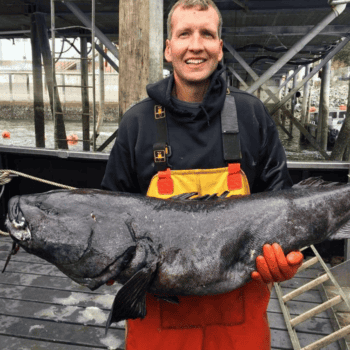Alaska. The name alone conjures images of rugged wilderness, towering glaciers, and an abundance of wildlife and, of course, freshly caught seafood.
The food is such a huge part of our yacht cruise experience! We serve halibut, salmon, rockfish, black cod, cod, muscles, shrimp, clams, Golden Crab, Dungeness crab, tuna, and whatever else we catch and find in season!
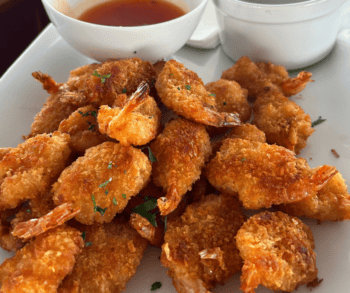
Bang Bang Shrimp!
In this blog post, we will delve into the exciting world of black cod fishing with Captain Harley aboard the M/V Last Chance and how we prepare the fish to savor their unique flavor in a truly unforgettable culinary experience for our cruises aboard the Northern Song – Alaska Sea Adventures.
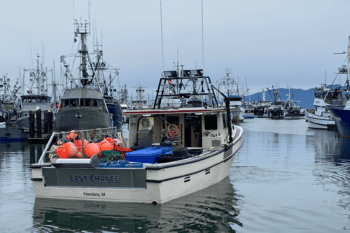
M/V Last Chance Heads Out Fishing for Black Cod in Washington
Captain Harley started his career as a commercial fisherman with over 40 years of experience. He fishes black cod from October to December, Dungeness crab from January to March on the M/V Last Chance, and then runs the M/V Northern Song with Alaska Sea Adventures from March to October for Alaskan and San Juan Island cruises.
Guests gain valuable insights into seafood sourcing, including how it’s caught and what fishing vessel types are used, current industry trends, sustainability practices, and the future outlook for wild and farmed fish.
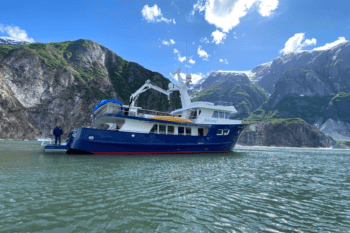
M/V Northern Song – Alaska Sea Adventures in Tracy Arm Fjords
Black Cod: A Deep-Sea Treasure
Black cod, also known as sablefish, is a deep-sea dweller that thrives in the icy waters of the Alaskan and Washington coasts. Typically found at depths ranging from 700 to 3,000 feet below the ocean’s surface, catching these fish requires experienced fishermen and specialized gear.
These fish are known for their impressive lifespans, with some estimated to live over 90 years.
The high oil content in their flesh gives black cod its signature rich, buttery flavor. This oil helps them survive their deep-sea habitat’s intense pressure and cold temperatures. Its rich, buttery flesh and delicate flavor have earned it a place among the world’s most coveted seafood. As Captain Harley says, “It’s the best fish you’ve never tasted!”
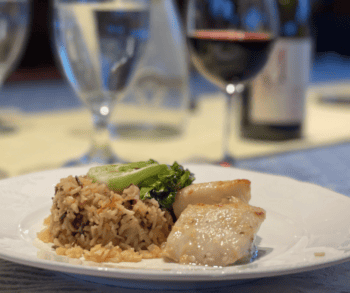
Black Cod Prepared for the Alaska Sea Adventures Travelers
Fishing for Black Cod with the M/V Last Chance
Once the October cruises aboard the Northern Song wrap up, Captain Harley moves to fish black cod off of the coast of Washington aboard the M/V Last Chance. Harley and a crew member set out to catch thousands of pounds of black cod. An average fish weighs 5-10 pounds.
Here is a HUGE black cod fish Harley caught in his earlier commercial fishing days!
Black cod fishing in November and December can be challenging due to the weather. These brown bags sitting on the side of the boat below are squid. The bait is placed inside a bait jar and put in a slinky pot to attract the fish and protect the black cod so the sperm whales don’t eat the fisherman’s catch.
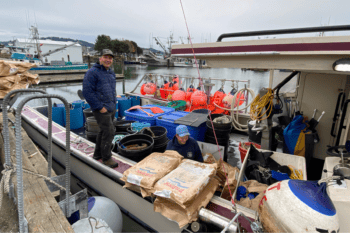
Watch here as crew member Ryan Walker demonstrates how black cod is caught in a slinky pot.
Once the fish is caught and processed, Captain Harley services it aboard the M/V Northern Song for the cruises and sells it to local seafood distributors in Washington and the Bellingham Dockside Fish Market, which happens two Saturdays a month! If you are in the Bellingham, Washington area, this is a fantastic way to learn more about locally caught seafood and pick up some of the freshest seafood directly from the fisherman.
Harley demonstrates how to cook black cod at the Bellingham Dockside Market in Bellingham, Washington.
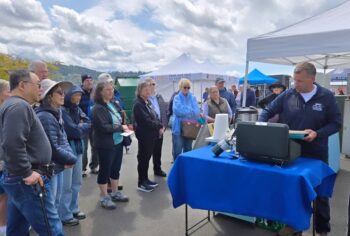
A Culinary Adventure
Did we mention that cuisine is a large part of our cruise experience, so be prepared to indulge? We incorporate Harley’s commercial fishing experiences into our culinary offerings, serving a variety of delicious black cod dishes. Here is an Alaska Sea Adventures favorite!
“Burn the Hell Out of It” Black Cod
Ingredients
1-2 black cod fillets from Jean C Family Fisheries
Soy sauce or soy sauce alternative
Directions
Defrost your black cod. Once defrosted, cut the fillet into individual portion sizes (one whole fillet will cut into 4-5 portions, and many people eat 2 portions).
Marinate the portions in soy sauce or soy sauce alternative (we use gluten-free tamari or coconut aminos) for 1-3 hours.
Heat your oven or grill to 450-400 degrees. Place skin side down right on the grill or on a pan. We use parchment paper in the oven on top of a baking sheet.
Cook for 12-18 minutes until the fish can easily flake. Serve hot with your favorite side or on top of a salad.
Conclusion
Is your mouth watering and ready for a true Alaskan adventure?
Join us for a journey filled with incredible seafood, fascinating insights into Alaska’s history from a local commercial fisherman, breathtaking sights like calving glaciers and massive icebergs, encounters with humpback whales and porpoises, the forging of new friendships, and an all-around unforgettable experience. Let’s make some memories!
Book your Alaskan Adventure & Culinary Delight today!
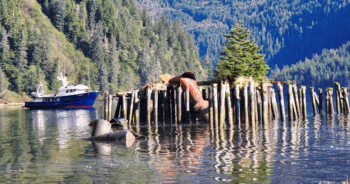
M/V Northern Song – Southeast Alaska
The killer whale is a magnificent, powerful apex predator. In this captivating footage, our guests witness a poignant moment in the circle of life as a pod of orcas, including young calves, work together to hunt a sea lion in Southeast Alaska. This natural behavior, while essential for survival, is a testament to the intricate balance of the marine ecosystem.
Orcas in the colder waters primarily feed on fish such as salmon, herring, and cod. Some orcas, typically the transient ones, hunt marine mammals, including seals, sea lions, dolphins, porpoises, and other whales. The transient orcas have more prominent, stronger teeth that are better suited for capturing marine mammals.
An adult killer whale can consume approximately 551 pounds of food per day. A growing calf might only consume up to 10% of its body weight daily.
Killer whales are highly intelligent and adaptable animals. Their diet can change based on the availability of prey and their specific ecological niche.
The difference in diet between the resident and transient killer whales results from genetic and behavioral adaptations that have evolved over time.
It’s important to note that while this is a part of the natural world, the footage is presented in a way that is not gory or gruesome. Alaska Sea Adventures First Mate Bart Oosthuizen captured this amazing footage!
.
Join Alaska Sea Adventures for an all-inclusive yacht cruise through Southeast Alaska for incredible whale watching! What if you could witness this? This Alaskan adventure yacht cruise is truly a trip of a lifetime!
Old Timer, a male first photographed in 1972, was spotted in July 2024 near Alaska, enduring in the Pacific Ocean while some other humpbacks have struggled in a changing environment.
The humpback whale Old Timer, was spotted by Dr. Adam Pack on July 29, 2024, in Frederick Sound in Southeast Alaska aboard the M/V Northern Song with Alaska Sea Adventures on the annual Focus on Whales yacht cruise.
Adam Pack/NOAA Research Permit 26953 aboard the M/V Northern Song had eight guests, along side Captain Harley Ethelbah spotting and helping to document whales for his research to take back to the The Whale & Dolphin Institute.

Bulletin Board on the M/V Northern Song
A humpback whale’s tail is as unique as a fingerprint. The lobes, or flukes, at the end of the tail have scalloped edges that vary from whale to whale; the undersides feature distinct black-and-white patterns that mark a whale for life. You can see a photograph aboard the M/V Northern Song that showcases many of the different unique patterns.
When Adam A. Pack, a marine mammal researcher at the University of Hawai’i at Hilo, was photographing whales in Alaska’s Frederick Sound in July, he photographed the whale and then submitted the photograph to Happy Whale to verify its identification.
Happy Whale is a unique artificial intelligence tool to capture whale patterns where they travel to, and who last spotted them.
Artificial intelligence-powered photo-matching algorithms help automatically identify the whales in submitted photos, aiding scientists in the field or others who need to look up previous sightings of a given animal.
“Happywhale has revolutionized our field and has made large-scale collaborations possible,” Dr. Pack said.
Dr. Pack was elated that evening to find out that his old friend “Old Timer” was alive as he was first spotted in 1972.
Old Timer is a male of at least 53 years, making him “the oldest known humpback whale in the world,” said Dr. Pack, who is also the co-founder and president of The Whale & Dolphin Institute.

Old Timer History
Dr. Pack had worried about Old Timer: The last time he had seen the whale, in 2015, was in the middle of a record-breaking, years long heat wave. Scores of seabirds and marine mammals, including humpback whales, died.
But after nine years, he saw with his eyes that Old Timer was still alive!
“It was heartwarming because I realized it wasn’t just the old whales who were perishing,” Dr. Pack said. “Some of them were resilient.”
Historically, tracking the whereabouts of the whales has been done the hard way: by scientists using their own eyes to compare new fluke photos with old ones. But future studies of Old Timer and other humpbacks of all ages are set to be accelerated with artificial intelligence. And Dr. Pack hopes it will help him learn how, and why, some whales can withstand harsh conditions.
Multiple humpback populations dwell in the North Pacific. Old Timer is part of a population that spends winters breeding in the waters around Hawaii and summers in southeastern Alaska, filling up on fish and tiny shrimp like animals known as krill or herring. These humpbacks have been the subject of an ongoing scientific study, which began in 1976 when a marine mammal researcher, Louis Herman, began photographing the whales and their distinctive flukes.
Dr. Herman conducted annual surveys, amassing an enormous collection of tail pictures that allowed scientists to keep tabs on individual whales over the course of their lifetimes. These fluke photos, which now number more than 30,000, have provided new insight into the lives of whales, from their migration patterns to their social behaviors.
“It’s one of the longest ongoing scientific studies of humpback whales in the world,” said Dr. Pack, one of Dr. Herman’s former students and colleagues and now leader of the whale project.
Earlier this year, Mr. Cheeseman, Dr. Pack and dozens of other researchers used Happywhale’s image recognition tool to estimate humpback whale abundance in the North Pacific from 2002 through 2021. Initially, the population boomed, climbing to about 33,500 whales in 2012.
But then it dropped sharply. This population decline coincided with the severe marine heat wave when Dr. Pack last spotted Old Timer. It lasted from 2014 to 2016 and slashed the supply of fish and krill. “There’s a lot more we want to learn about the event, but it is quite clear: warmer waters mean food is less available overall, and what is available is more dispersed and deeper,” Mr. Cheeseman said in an email.
The Hawaii humpback population was especially hard hit, falling 34 percent from 2013 to 2021. Although there had been some sightings of Old Timer reported after 2015, Dr. Pack was excited to finally set eyes on the whale himself. That excitement soon gave way to curiosity: Why had Old Timer survived when so many others had perished?
Now, Dr. Pack is hoping to dive deeper himself, with the help of Happywhale. He plans to investigate how humpbacks survived the lean years and whether there are any discernible patterns. Could Old Timer’s age have been an advantage?
“It is possible that Old Timer’s been around enough to be adaptable when certain food resources are limited,” Dr. Pack said.
The idea remains speculative, and it is not yet clear whether Old Timer was the exception or the rule. “How many whales like Old Timer were resilient to this devastation of marine resources?” he said.
Overall, it was a fabulous Alaskan cruise, spotting over 200 whales in 8 days, witnessing countless amounts of bubble-feeding, and seeing Old Timer!

Bubble-net Feeding
This article should be credited to Emily Anthes is a science reporter for the New York Times, writing primarily about animal health and science. Additional information was reported by local Alaskan Captain Harley Ethelbah with Alaska Sea Adventures, who has been cruising the Inside Passage for over 40 years.
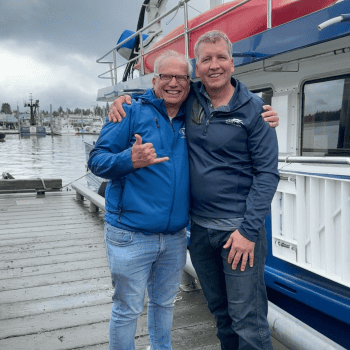
Dr. Adam Pack & Captain Harley Ethelbah
There are two annual Focus on Whales cruises aboard the M/V Northern Song in July. They are heavily focused on the Inside Passage and whales, but there are many other incredible sites to experience, including glaciers, bears, hot springs, and incredible cuisine. Learn how to hop aboard a whale cruise with whale and dolphin scientist Dr. Adam Pack and experience his incredible work at Alaska Sea Adventures!
This is the ultimate adventure for whale and dolphin enthusiasts.
What is the difference between a large Holland America cruise to Glacier Bay in Alaska versus a small 8-10 passenger yacht cruise through Southeast Alaska, and which one is right for you?
Here, we dive into why take an Alaskan cruise, what makes each unique, and how much an Alaskan cruise costs so you can choose what experience you’re looking for!
Large Alaskan Cruise Ships
The larger Alaskan cruise ships, like Holland America, are approximately 780 feet long and carry 1,500-2,000 people per cruise.

The larger ships offer many amenities, including multiple dining options, theaters, casinos, onboard shopping, spas, pools, and fitness centers. These cruise ships feel like a city with a bustling, energetic atmosphere and live entertainment with many activities and options onboard and a view from your deck.

How much does an Alaskan cruise cost?
These large cruise ships can be more economical due to the large number of people aboard, and they can be an excellent option for budget-conscious travelers. The prices can start at $1,000 to $5,000+ per person for 7 to 10 days.
Your shore excursions are booked separately, so an additional cost depends on your interests and what you want to experience in the ports. Some activities include whale watching, fishing for a halibut, town tours, or shopping. These ships give you a more traditional cruise experience focused on the boat’s features and the onboard activities versus adventure.
These large Alaskan cruise ships, like Holland America, will stop in major ports like Juneau, Ketchikan, or Skagway for your day excursions. These towns often have five large ships daily in port; therefore can get entirely inundated with travelers. The number of travelers can sometimes exceed the actual number of residents. In 2020, the population in Ketchikan, Alaska, was 13,948.
Where does a large cruise ship depart and return to?
These ships can leave from Vancouver, BC, Canada, Seattle, Washington, or Seward, Alaska, and cruise to Southeast Alaska.
What is the cuisine like on an Alaskan cruise ship?
These larger ships tend to have multiple dining options, including local cuisines, upscale fine dining restaurants, casual, more buffet-style restaurants, or international options such as Italian, Asian, or French-flavored dishes. There are several ethnicities and experiences to choose from.

Let’s compare a smaller Alaskan cruise to see what makes the most sense for you!
Smaller Alaskan Yacht Cruise
A smaller wooden boat or yacht cruise may carry 6-20 passengers, and the approximate length is 85 -120 feet.

Since yacht cruises naturally have fewer passengers, this leads to less congestion in public areas and when heading ashore for excursions. These smaller Alaskan cruises may not stop at the large ports. They are focused on finding more unique rugged highlights or the locals favorite stops throughout the Inside Passage.
How much does an Alaskan yacht cruise cost?
The smaller boats or yacht cruises are generally more expensive due to the smaller number of passengers, the higher level of service with crew, and the more intimate adventures in the region. These Alaskan yacht cruises can range from $6,000 to $12,000 per person for 8 days, or if you wanted the entire boat, this could average $60,000 – $70,000 for 8 days for 6-12 passengers. This is a fabulous way to gather your friends and family and plan your cruise based on your Alaskan bucket list and what you want to see.
Typically, these costs include the excursions, as they are the focus of the adventures aboard the boat!
The smaller yacht cruises focus on a more immersive and adventurous experience. They may take you out on side trips, kayaking, or a tender boat into the local areas’ hidden gems.
In Southeast Alaska, US Forest Service Permits are required in these remote areas. Cruise ships cannot put people on the beaches without permits or travel in certain regions. The limited number of permits helps to manage the number of boats and preserve the rugged naturalness that makes Alaska so special. The passenger doesn’t typically pay anything additional for the licenses, but each yacht charter may charge differently. It isn’t like a day excursion fee. So, it can be important when choosing a cruise to ensure your yacht charter has many licenses for the areas you may want to explore in Southeast Alaska or Glacier Bay.
Smaller cruises can also visit more unique destinations that larger ships cannot access due to the size of their boat. That inlet or bay just may not be deep enough. Petersburg, Alaska, is a community of Norwegian folks made up of commercial fishing, and this is one of those ports the large boats can not get into due to the size of the Wrangell Narrows. They can’t get through there due to the depths and narrow passage.
These smaller yacht charters will visit more rural ports and destinations like Petersburg, Kake, Baranof Warm Springs, Le Conte Glacier, or Five Finger Lighthouse, which are areas that the larger ships can’t get into. These small villages and local highlights make Alaska rich in culture and adventure!
Some of the activities you might experience aboard a yacht charter are:
- Whale watching for humpback whales or killer whales
- Spotting wildlife such as bears, porpoises, sea otters, seals, deer, or moose
- Visit a sea lion rookery
- Bald eagles and many other birds
- Soak in a hot spring
- Fishing for halibut, salmon, shrimp, or crab
- Lighthouses
- Hiking to waterfalls or beach-combing
Le Conte Glacier is the southernmost tidewater glacier in the Northern Hemisphere and not a destination for large ships. Le Conte Glacier is located 25 miles from Petersburg and is a favorite due to all the caving ice.

Travelers get an up-close view of the large icebergs in Le Conte Bay

Soaking in Baranof Warm Springs
Hidden Falls, also known as the bear hatchery. Hidden Falls Hatchery is one of the largest salmon hatcheries in the Baranof Island region in Southeast Alaska. It‘s renowned for its substantial contribution to the local fishing industry, releasing millions of salmon fry annually. We call it the bear hatchery, as the bears show up to feed on the salmon. These are some well-fed brown bears!

Hidden Falls Hatchery
This off-the-beaten-path, hidden local gems are the experiences you can expect to adventure into on a smaller, locally captained yacht cruise.
So, if you have an adventurous spirit, this is an incredible way to experience Southeast Alaska and truly a lifetime trip!
Where does a private yacht charter start?
They typically start in Southeast Alaska in Juneau, Petersburg, or Ketchikan. This gives you more time in the local area to explore versus traveling long distances on the boat at a time and just viewing the scenery.
What is the cuisine like on an Alaskan yacht cruise?
A yacht cruise is a smaller, more intimate dining experience, so typically, everyone eats together in a family style. This can be a great way to chat with the Captain or local crew and learn more about the region, their local experiences, and the history firsthand.
As you know, Alaska has an incredible abundance of seafood, so you may experience wild Alaskan salmon, freshly caught halibut, King or Dungeness crab, rockfish, clams, or even glacier ice in your cocktails! The onboard chef will typically accommodate food requests such as gluten-free or vegetarian.

Fresh Alaskan Halibut – Alaska Sea Adventures
Conclusion
Ultimately, your best choice depends on your budget, personal preference for how you want to experience Alaska and priorities. If you are looking for a more traditional cruise experience with a wide range of amenities and onboard activities, with the boat more of the experience, a large cruise ship may be a good option. You will see many of these large boats cruising into Glacier Bay and can sit back and enjoy the scenery and have the entertainment of a big ship!

If you are looking for a more intimate and adventurous Alaskan experience, you can tailor to your Alaskan bucket list, getting up close to the face of the glaciers, wanting to experience all the wildlife such as whales, sea otters, and bald eagles, cruising through the fjord’s, some fishing, and no schedule so you can linger on that pod of whales breaching and exploring the rugged outdoors, then a small boat cruise would be the choice for you!

Alaska Sea Adventures – M/V Northern Song and a Float Plane Ride
Alaska Sea Adventures is an all-inclusive, 8-10-passenger yacht cruise. We take you through the ice, closer to glaciers, and travel across waters where others can’t go due to the challenges of the sea, with our 85-foot custom expedition yacht. This motor vessel is built for Alaska with a steel hull for bumping up against the ice and NIAD stabilizers for a comfortable cruise!
During our 50 years, we have accumulated over 800 US Forest Service permits, taking you to remote areas where other charters can’t go.
Our 6-pole halibut permit allows you to catch that Alaskan “butt” (halibut)!

Yelloweyed Rockfish
Captain Harley, a local commercial fisherman, leads Alaska Sea Adventures. So, your yacht cruise will be immersed in the region’s locally sourced ingredients.
Cuisine and local seafood are Harley’s passions, so this is an internal part of your experience. Each evening, Harley shares his 40 years of fishing expertise during dinner, explaining the catch of the day and how the commercial fishing industry has evolved.

Golden Crab Feast, Seafood Risotto, and Shakshuka for Breakfast
You might even catch a glimpse of commercial fishing boats in action or haul a crab pot yourself!
Ultimately, the best choice for you depends on your personal preference of how you want to experience Alaska and your priorities. If you are looking for a more traditional cruise experience with a wide range of amenities and onboard activities, with the boat more of the experience, a large cruise ship may be a good option.
Suppose a more adventurous exploration focusing on exploring the magical details of the Inside Passage, getting up close to the face of the glaciers, and viewing the bears feeding in the streams is what you’re looking for.
In that case, a small yacht cruise is truly incredible. Not being on a schedule is pretty luxurious, so you can have the freedom to snap 100 pictures of that pod of whales breaching and exploring the fjords; then, a small boat cruise may be the right choice for you and your family!

Alaska Sea Adventures – M/V Northern Song and a Humpback Whale
An Alaskan yacht cruise is more than just a trip; it’s an immersive experience into one of the world’s most breathtaking landscapes. Download our curated bucket list guide to inspire your Alaskan adventure!


A view from Mount Constitution on Orcas Island

Lopez Island, Washington
This is Dr. Adam Pack from the “Focus on the Whales” cruises and Professor and Chair (Psychology)
Departments of Psychology and Biology University of Hawai’i at Hilo.
Focus on Whales cruises are always a summer favorite. One of my highlights this past summer were working closely with my incredible group to document individually identified humpback whales from our mini-catalog and find out the life histories of these whales.
2023 represented my 15th Alaskan yacht cruise leading Focus on Whales in Southeast Alaska.
It’s always exciting for me to return from Hawai’i, where I live and teach at the University of Hawai’i at Hilo, to the same waters my mentor Dr. Lou Herman and his students surveyed for humpback whales on their feeding grounds from 1980-1986.

During my first summer in Frederick Sound and Chatham Strait in 2007, I was amazed that many of the same whales Dr. Herman first photographed in those early years were still around!
In the years that followed those early pioneering efforts, it became clear that most humpback whales in Southeast Alaska spent their winters in the warm breeding grounds of Hawai’i.

Over the years, with our Focus on Whales groups, I have traced the migratory destinations of individual whales across the 2500-mile journey between Hawai’i and Alaska.
Our archival catalog of North Pacific humpback whales now numbers well over 25,000 observations of more than 7,000 individuals dating back to 1976! From this archive, Naturalist Jim Nahman and I developed a mini catalog of some of our most well-sighted and most beloved humpbacks.

Focus on the Whales Guides Dr. Adam Pack & Jim Nahmens
This summer, our group identified 12 of the 42 mini-catalog whales. For every sighting, we looked up the long-term history of the whale using the innovative and revolutionary automated online matching program “Happy Whale.”
Our discoveries included a whale we call “Dog face,” who has been sighted numerous times in Frederick Sound hunting schools of herring cooperatively with other whales using a loud feeding call and a bubble net, and who we have also seen in Hawai’i competing with other males for mating access to a single female in what we term a competitive group.
To witness a whale competing in one context and cooperating in another across thousands of miles is amazing. According to Happy Whale, Dog face, first sighted on August 27, 1996, in Alaska, has been sighted 54 times total in Alaska and nine times in Hawaii.

“Dog face” also named “Equilibrium” and “Mahalo” in Happy Whale sighted on July 24, 2023, the first of the mini-catalog whales our 2023 group sighted.

Dog face photographed March 7, 2019 in Maui, Hawai’i competing aggressively with other males for a female.
June 26, 2023, we documented a whale we call “V cut,” a name we attributed to the distinctive notch out of its right tail fluke edge. It is known in Happy Whale as “Finger and Epilmeletic.”
We observed V cut participating in a cooperative feeding group of humpback whales off the Big Creek shoreline in Frederick Sound. When we uploaded V cut’s fluke image into Happy Whale, it revealed that V cut had been sighted 79 times in Alaska but only once in Hawai’i.
Thinking this a bit odd, when I returned to my University of Hawaii at Hilo Marine Mammal Laboratory, I combed through hundreds of photographs of humpback whales we are in the process of uploading to Happy Whale, and lo and behold found V cut way back in 1991 in Hawaii.
These recognizable whales are just a few of the many from our catalog that our Focus of Whales cruises photographed in 2023 and helped match and trace between Alaska and Hawai’i.

V cut photographed by Jana Johnson on June 26, 2023 hunting herring cooperatively along the Big Creek shoreline in Frederick Sound Alaska.
“V cut” photographed in Hawaii on March 23, 1991 was a mother to a newborn calf in a competitive group.
They warmed our hearts, filled our minds with wonder, and became the subject of numerous discussions over many amazing meals as we celebrated these long-lived majestic mammals aboard the MV Northern Song.
Explore Focus on the Whales Cruises

